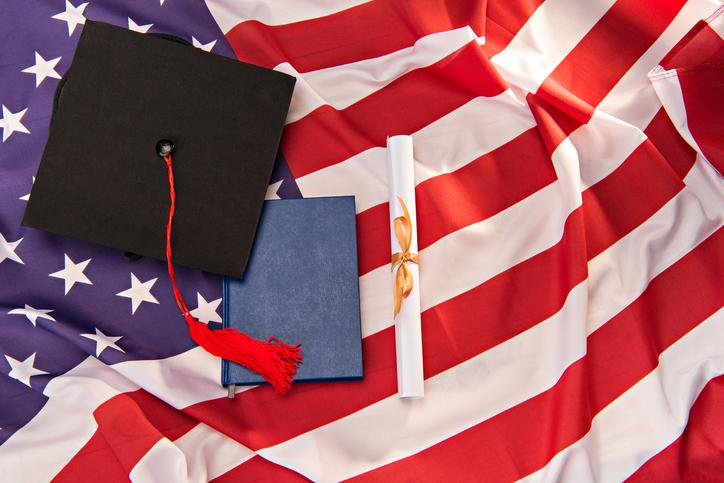Study in the USA


Study in the USA
The United States is a premier global destination for international students, renowned for its high-quality education, innovative curriculum, and vibrant multicultural environment. It offers unparalleled opportunities for personal and professional growth.
Why Study in the US?
- Global Leadership in Higher Education: The U.S. is home to 10 of the top 20 universities in the world, according to the QS World University Rankings 2025.
- Diverse Educational Opportunities: With over 4,000 higher education institutions, including large research universities and small liberal arts colleges, the U.S. provides a wide spectrum of academic and social environments.
- Research and Innovation: The U.S. leads globally in research and development spending. Universities are at the forefront of research, technology, and innovation, offering students opportunities to work alongside distinguished faculty on transformative projects.
- Cultural Diversity: The U.S. hosts over 1 million international students, making it the most popular destination for foreign students globally.
- Career Opportunities: Many education programs are aligned with industry needs, offering practical experience through internships and training with leading global corporations, which contributes to strong employability rates for graduates.
- Flexible Curriculum: U.S. universities often provide flexible course options, allowing students to tailor their studies to specific interests and career goals, fostering a broader educational experience and innovative thinking.
- Support Services for International Students: Universities offer robust support systems, including orientation programs, English language classes, and assistance with visa status and employment opportunities, easing the transition for international students.
Top Courses to Study in the US
The most preferred fields by international students include:
- Engineering and Computer Science
- Life Science
- Business Management
- More Information: Courses to study abroad
Top Universities to Study in the US (QS Ranking 2025)
Here are some of the top American universities:
- Harvard University
- Stanford University
- Massachusetts Institute of Technology
- Princeton University
- University of California, Berkeley
- University of Pennsylvania
- California Institute of Technology
- Columbia University
- Cornell University
- More Information: Times Higher Education charts
Intakes Available in the USA
Unlike a single intake in many other countries, American colleges and universities typically offer three intakes, sometimes referred to as semesters:
- Fall Intake: The most popular intake among Indian students, starting in September.
- Spring Intake: Starts in January, a good option if you miss the September intake.
- Summer Intake: Available for limited programs and colleges, usually starting around May.
- More Information: Intakes in the USA
Cost of Studying in the USA
Universities in the US are broadly categorized as Public/State and Private. Public/State universities generally have lower tuition fees than private institutions. Tuition costs depend on the type of qualification and the specific institution.
Here's an indicative range of annual tuition fees:
| School/Program | Tuition Fees (USD, indicative per year) |
|---|---|
| English language studies | $700 to $2,000 per month |
| Community colleges | $6,000 to $20,000 |
| Undergraduate bachelor degree | $20,000 to $40,000 |
| Graduate programs | $20,000 to $45,000 |
| Doctoral degree | $28,000 to $55,000 |
Please note that an MBA degree and professional programs (like law, medicine, dentistry, some design programs) can cost significantly more. Most doctoral degrees are often 100% funded through research/teaching assistantships, research aid, and bursaries.
Scholarships to Study in the USA
The amount and type of scholarship vary between institutions. Some research programs may cover up to 100% of the tuition fee and part of your living expenditures. To help reduce educational expenses, here are some popular scholarship programs for international students:
- Fulbright-Nehru Fellowships (Government-funded): For master’s or PhD programs, covering tuition fees, accident and sickness coverage, airfare, and living costs.
- Hubert H. Humphrey Fellowship Program (Government-funded): Part of the Fulbright program, for accomplished young and mid-career professionals from developing countries to undertake 10 months of non-degree graduate study and practical experience.
- #YouAreWelcomeHere Scholarship (Non-Government): A scholarship and social media campaign welcoming international students into the U.S. higher education system across all subject areas.
- AAUW International Fellowships (Non-Government): Awarded to international women students for full-time study and research in U.S. accredited institutions, supporting both graduate and postgraduate students.
- More Information: U.S. scholarships
Student Visa Requirements for the US
The U.S. Government offers three different student visa types:
| Type of Student Visa | Description |
|---|---|
| F-1 Student Visa | For study at an accredited U.S. college or university, or at an English language institute. |
| J Exchange Visa (J-1) | For participation in an exchange program, including high school and university study. |
| M Student Visa (M1) | For non-academic or vocational study or training in the U.S. |
For detailed information, please visit the US Government’s Department of State website.
Top Student Cities in the US
The U.S. is known for its world-renowned education system and dynamic student experiences. Here are some of the top student cities in the U.S., as highlighted by the QS Best Student Cities Rankings 2025:
| City | Rank |
|---|---|
| Boston | 16 |
| San Francisco | 29 |
| Los Angeles | 37 |
| Chicago | 44 |
| Philadelphia | 65 |
| San Diego | 69 |
| Washington DC | 70 |
Cost of Living in the USA
Living costs in the U.S. vary significantly by region, with urban areas generally being more expensive than smaller towns or suburban areas. When budgeting, consider these common expenses:
| Expenses | Average Yearly Cost (USD, indicative) |
|---|---|
| Books and Stationery | $500 - $1,000 |
| Traveling | $500 - $1,200 |
| Food | $2,500 |
| Clothes and Footwear | $500 |
| Miscellaneous Expenses | $2,000 |
Note: All costs are indicative and may vary from region to region.
Work Opportunities in the USA During and After Studies
The U.S. education system allows international students enrolled in U.S. institutions to participate in co-ops, internships, part-time, and even full-time jobs. However, authorization from relevant authorities (through the school's international office or U.S. Citizenship & Immigration Services (USCIS)) is required. The three types of employment authorization options available for international students are:
- Curricular Practical Training (CPT)
- Optional Practical Training (OPT)
- On-campus employment
Frequently Asked Questions (FAQs) Related to US Education
- How much will it cost to study in USA? Tuition fees in the United States generally range from $8,000 to $55,000 (USD) per year. Public/State universities typically have lower fees than private institutions. Specific program costs include: English language studies ($700 to $2,000 per month), community colleges ($6,000 to $20,000 per year), undergraduate bachelor's degrees ($20,000 to $40,000 per year), graduate programs ($20,000 to $45,000 per year), and doctoral degrees ($28,000 to $55,000 per year).
- What is the duration of foundation or diploma programs in the US? Typically, these programs last one year. Students need to achieve satisfactory grades to progress to the first year of their bachelor's degree. Most programs start in September, though some providers may offer multiple intakes.
- What are the popular scholarships to study in the US? Popular scholarships include Fulbright-Nehru Fellowships, Hubert H. Humphrey Fellowship Program, #YouAreWelcomeHere Scholarship, and AAUW International Fellowships.